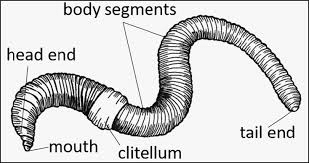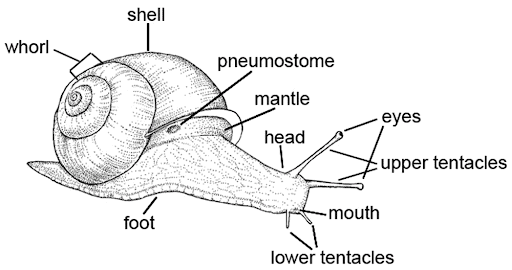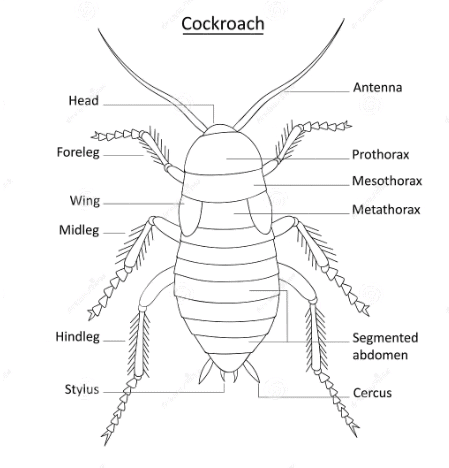Class 6 Exam > Class 6 Notes > Science Olympiad Class 6 > Short Notes: Body Movements
Body Movement Class 6 Notes Science Chapter 5
What is Locomotion?
- Locomotion refers to the movement of the whole body from one location to another.
- Locomotion provides a structure that helps shape and support the body.
- The human body is made up of 206 bones.
- Bones serve to protect the internal organs.
Parts of Human Skeleton
The bones in our body create a framework known as the Skeleton. The human skeleton consists of two main parts:
- Axial skeleton system: This part includes the skull, vertebral column, and the bones of the chest, also known as the rib cage.
- Appendicular skeleton system: This part consists of the hip girdles, shoulders, and limbs.

Joints
The point at which two separate bones meet is called a joint. There are four types of joints in the human body.
Ball and Socket Joints
- One end of a bone is rounded and ball-like and fits into a cup-like depression of the other bone.
- This joint provides movement in any direction.
- Shoulder joints and hip joints are examples.
- In the shoulder joint, the head of the humerus fits into a socket of the shoulder girdle.
- In the hip joint, the large ball-like head of the femur fits into the deep socket of the hip girdle.
Hinge Joints
- The hinge joint functions similarly to a door hinge, allowing movement in only one direction.
- An example of a hinge joint is the elbow joint, which connects the humerus and the ulna.
- Hinge joints can also be found between the bones in your fingers and toes, as well as, to a lesser degree, in the knee joint.
- These joints are typically strong and provide enough power for movement while minimizing the risk of twisting at the joint.
Question for Short Notes: Body MovementsTry yourself: Which type of joint allows movement in any direction?View Solution
Pivotal Joint
- One bone rotates over a pivot-like end of the other bone.
- The skull rotates on the upper end of the backbone.
Fixed Joints
- In this joint, no movement is possible between the two bones.
- The sutures between the bones of the cranium are an example.
Bones and Skeleton
- The skeleton is a framework of all the bones in the human body.
- The skeleton consists of the skull, hand bone, shoulder bone, rib cage, pelvic bone, backbone, leg bone, and cartilage.
- The skull protects the brain.
- The shoulder has the ball and socket joint that helps the arm swing.
- The rib cage protects the lungs, heart, stomach, abdomen, and liver.
- The backbone runs from the top of the skeleton to the bottom of the skeleton.
- It is connected to all the bones.
- The pelvic bone protects the lower abdominal organs, such as the urinary bladder, rectum, and uterus.
- Cartilage is a soft bone tissue that connects joints.
- It is present in external parts like the ear and nose.
Gait of Animals
Earthworm

- Earthworms move easily on hard and slippery surfaces.
- They have tiny, stiff, hair-like projections called bristles under their body.
- These bristles help them grab the soil.
- Earthworms first stretch and then contract their muscles to move.
- As a result, they cover only a small distance with every move.
- A slimy substance secreted by the earthworm helps it to move.
- Earthworms eat their way through the soil.
- They throw away undigested food, which improves the quality of the soil.
Snail

- The outer skeleton of the snail, the shell, is made of calcium carbonate.
- The snail pulls this shell along as it moves.
- The snail can even hide its head inside the shell.
- The strong, muscular foot below the shell can protrude.
- The undersurface of the muscular foot is lubricated with mucus.
- Waves of muscular contractions along this surface help a snail move.
- The mucus also reduces the risk of injury from sharp objects.
- That is why snails can walk over sharp objects like blades without getting hurt.
Cockroach

- The cockroach has three pairs of legs that help it to walk.
- It has two pairs of wings that help it to fly.
- A cockroach moves its legs with the help of muscles near the limbs.
- It uses its breast muscles to move its wings and fly.
- A cockroach can walk, fly, and even climb.
- A cockroach can move in different terrains like sand and wired meshes.
- This movement is possible because of the spines on its legs.
Birds
- A bird has a body best suited for flying.
- Its wings are actually modified forelimbs.
- Birds can fly easily with the help of these bony forelimbs.
- Birds have light and hollow bones.
- The breast bones hold the muscles of flight that help them to flutter their wings.
- The tail controls the direction of flight.
- Birds have very strong shoulder bones.
- They don't have a urinary bladder, which helps them to fly easily.
- They can walk and perch on trees with the help of their hind limbs.
Question for Short Notes: Body MovementsTry yourself: Which joint allows for rotation of one bone over a pivot-like end of another bone?View Solution
How do Snakes Move?
- Snakes move in S-shaped loops and in a zigzag manner.
- They cannot move in a straight line.
- They have difficulty moving on very smooth surfaces.
- Snakes have a long backbone and many interconnected muscles that help them to slither.
- They have muscles connecting the backbone, ribs, and skin.
- Snakes can move in grass, sand, and water.
- Snakes do not have arms or legs, but they can climb trees.
Fish
- Fish have a streamlined body, which helps them move fast in water.
- Fish swim with the help of their fins.
- The tail moves from side to side, and helps the fish swim in the right direction.
- Some fish, however, move by bending their bodies from one side to another in quick succession, which produces a thrust that helps it move forward.
The document Body Movement Class 6 Notes Science Chapter 5 is a part of the Class 6 Course Science Olympiad Class 6.
All you need of Class 6 at this link: Class 6
|
74 videos|148 docs|104 tests
|
FAQs on Body Movement Class 6 Notes Science Chapter 5
| 1. What is locomotion and why is it important for animals? |  |
Ans. Locomotion refers to the ability of an organism to move from one place to another. It is important for animals as it enables them to find food, escape predators, seek mates, and explore their environments. Different animals have evolved various types of locomotion, including walking, running, swimming, and flying, which are influenced by their anatomy and habitat.
| 2. How do bones and the skeleton support locomotion in animals? |  |
Ans. Bones and the skeleton provide structural support and shape to an animal's body. They serve as levers for muscles, allowing for movement and locomotion. The skeletal system also protects vital organs and stores minerals. In different animals, the structure of bones varies to optimize their specific mode of locomotion, whether it be for running, jumping, or flying.
| 3. What are the different types of gaits observed in animals? |  |
Ans. Animals exhibit various types of gaits, which are patterns of movement. Common gaits include walking, trotting, cantering, and galloping in quadrupeds, while birds may exhibit flapping, gliding, or hopping. Each gait is adapted to the animal's body structure, energy efficiency, and the terrain they navigate, helping them move effectively.
| 4. How does the skeletal structure differ between terrestrial and aquatic animals regarding locomotion? |  |
Ans. Terrestrial animals typically have a robust skeletal structure with strong limbs designed for support and movement on land. In contrast, aquatic animals often have streamlined bodies and flexible skeletons that reduce drag and allow for efficient swimming. These structural differences reflect the adaptations necessary for their respective environments.
| 5. What role do muscles play in the locomotion of animals? |  |
Ans. Muscles are essential for locomotion as they contract and relax to produce movement. They work in conjunction with bones to facilitate various types of locomotion. For example, in walking, muscles help lift and propel the body forward, while in swimming, they create undulating movements that push against the water. The coordination between muscles and the skeletal system is critical for effective movement.
Related Searches






















